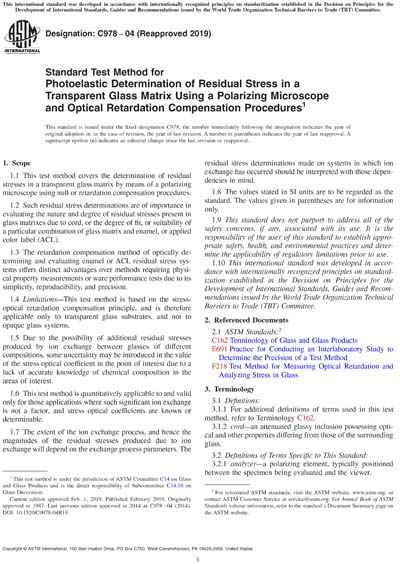Most recent
ASTM C978-04(2019)
Standard Test Method for Photoelastic Determination of Residual Stress in a Transparent Glass Matrix Using a Polarizing Microscope and Optical Retardation Compensation Procedures
1.1 This test method covers the determination of residual stresses in a transparent glass matrix by means of a polarizing microscope using null or retardation compensation procedures.
1.2 Such residual stress determinations are of importance in evaluating the nature and degree of residual stresses present in glass matrixes due to cord, or the degree of fit, or suitability of a particular combination of glass matrix and enamel, or applied color label (ACL).
1.3 The retardation compensation method of optically determining and evaluating enamel or ACL residual stress systems offers distinct advantages over methods requiring physical property measurements or ware performance tests due to its simplicity, reproducibility, and precision.
1.4 Limitations—This test method is based on the stress-optical retardation compensation principle, and is therefore applicable only to transparent glass substrates, and not to opaque glass systems.
1.5 Due to the possibility of additional residual stresses produced by ion exchange between glasses of different compositions, some uncertainty may be introduced in the value of the stress optical coefficient in the point of interest due to a lack of accurate knowledge of chemical composition in the areas of interest.
1.6 This test method is quantitatively applicable to and valid only for those applications where such significant ion exchange is not a factor, and stress optical coefficients are known or determinable.
1.7 The extent of the ion exchange process, and hence the magnitudes of the residual stresses produced due to ion exchange will depend on the exchange process parameters. The residual stress determinations made on systems in which ion exchange has occurred should be interpreted with those dependencies in mind.
1.8 The values stated in SI units are to be regarded as the standard. The values given in parentheses are for information only.
1.9 This standard does not purport to address all of the safety concerns, if any, associated with its use. It is the responsibility of the user of this standard to establish appropriate safety, health, and environmental practices and determine the applicability of regulatory limitations prior to use.
1.10 This international standard was developed in accordance with internationally recognized principles on standardization established in the Decision on Principles for the Development of International Standards, Guides and Recommendations issued by the World Trade Organization Technical Barriers to Trade (TBT) Committee.
Content Provider
ASTM International [astm]






